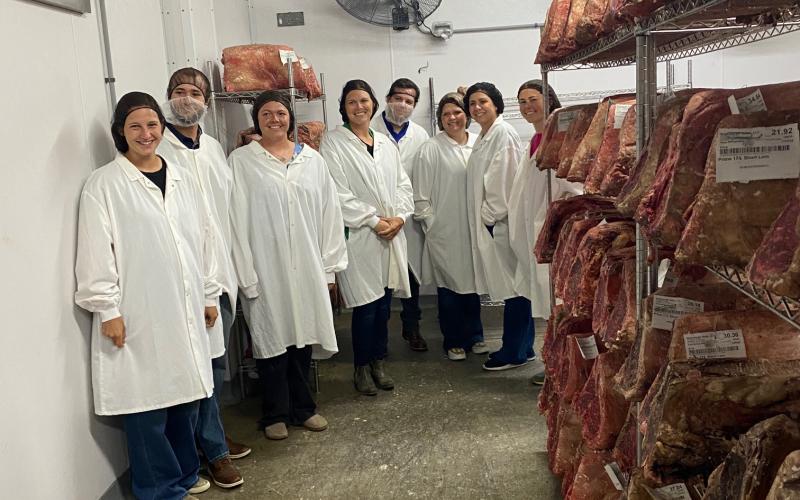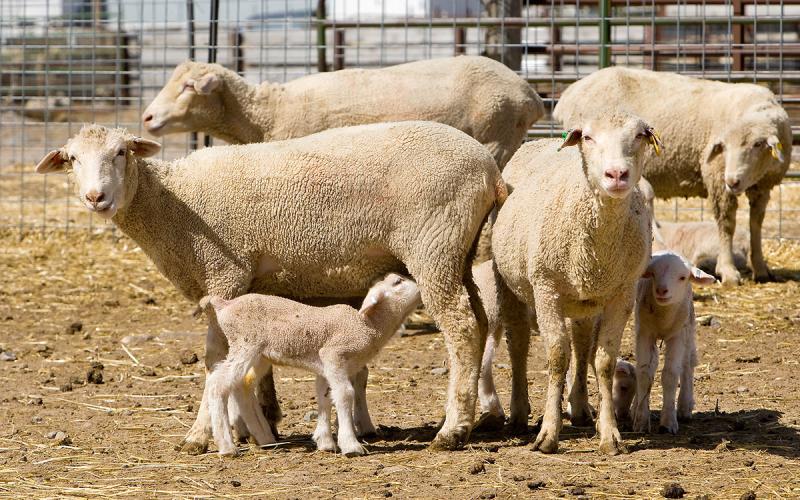
Written with contributions by Heidi Carroll, former SDSU Extension Livestock Stewardship Field Specialist & Beef Quality Assurance Coordinator, and Kelly Froehlich, former Assistant Professor & SDSU Extension Sheep and Goat Specialist.
Sheep and goats are considered minor species within the U.S. Food and Drug Administration (abbreviated as FDA) definitions and have fewer FDA-approved drugs. A National Residue Program exists to protect food safety in meat and milk, and residue sample results from the U.S. National Residue Program for Meat, Poultry, and Egg Products are available for the public. From the annual FSIS scheduled residue sampling summaries, the 4-year average (2019-2022) violative samples for sheep and goats are double (0.8%) violations from hogs (excluding feral swine) and all cattle classes (0.4%). From 2019 to 2022, observed residue violations in sheep and goats included moxidectin (for example, Cydectin), oxytetracycline (for example, Terramycin or Liquamycin LA-200), piperonyl butoxide (for example, Pyranha 1-10PX and other pour-on), flunixin (for example, Banamine), gamithromycin (for example, Zactran), sulfamethazine (for example, Sulment), spectinomycin (for example, Scour-halt), eprinomectin (for example, Eprinex pour-on), tetracycline (for example, Aureomycin), tylosin (for example, Tylan 200 used in cattle or TyloCare), diclofenac (for example, DicloCare), and penicillin (for example, Pen-Aqueous).
Ultimately, the goal of raising livestock is food production. While some producers market their animals to larger packing plants, a growing number are choosing to direct market all or a portion of their animals and/or products. A trusting relationship built on the producer’s ability to provide safe, wholesome meat to the end user is the foundation of any good business model. Let’s review some key points of antibiotic stewardship and residue prevention programs on the farm to ensure safe, wholesome meat or dairy products.
Implementing an Antimicrobial Stewardship Program
Antimicrobial stewardship, which includes antibiotics, is the responsibility of preserving the effectiveness of antimicrobials while maintaining animal health. An on-farm antimicrobial stewardship program should be established and understood by all animal caregivers, both family and hired employees. Here are a few basic steps to implementing an antimicrobial stewardship program on your farm or ranch.
-
Establish and document a veterinary-client-patient-relationship.
Producers should discuss with their veterinarian the prevention of common diseases with full consideration of biosecurity and animal husbandry practices followed by creating a vaccination protocol. Documentation on an annual basis is a best practice to show an established veterinary-client-patient-relationship (abbreviated as VCPR). This documentation could be a VCPR template, clinic invoices, or veterinary service reports dated within the last twelve months. Remember, a valid VCPR is required for extra-label drug use and to fill prescriptions for treatments without physically seeing an animal. -
Develop written treatment protocols.
Know the common sheep or goat diseases and establish a written standard operating procedure (abbreviated as SOP) for diagnosing and treating each condition. Work with your veterinarian to determine the best treatment plan and determine which animal health products you will need to have on-hand versus those that will require swift action to acquire from your veterinarian. Written SOPs should include the objective of the SOP, class of animal (pregnant or non-pregnant ewe, ram, lamb), disease or condition, establishing a diagnosis with clinical signs, primary and secondary treatment options, who is trained/responsible to administer the procedure, the timeline for each treatment decision if recovery is not achieved, and identification of the appropriate recordkeeping system for treatments and drug use. -
Develop a permanent recordkeeping system for animal health procedures.
Treatment records should be kept on animals for at least two years from the time of sale. Records can be paper or electronic, as long as they are accurate and current. A treatment record should contain, at a minimum, the following information:- Treatment date.
- Animal identification.
- Dosage.
- Route of administration and expected duration.
- Withdrawal time for milk and meat.
- Individual administering the drug.
- Drug used.
-
Duration of therapy.
-
Review your permanent animal identification method.
Ask yourself, “Can I trace back a potential residue to an individual animal if the entire flock or herd is not treated?” If the answer is no with your current identification and penning of treated animals, you should identify ways to move towards individually identifying animals, so the treatment records are more precise. -
Maintain a documented drug inventory for all animal health products.
A simple notebook or paper on the barn refrigerator can help you show how much you purchase and how much is used or disposed. These sheets are also a great way to keep expired products out of your inventory. -
Read all product labels thoroughly.
Reading labels is critical for appropriately treating or vaccinating any animals. It can also be helpful to keep the current product labels, boxes, or inserts to refer back to if questions arise. Product labels are also available online for download. Transfer all the required information from the label to your treatment records. It is also good to record lot and serial numbers of the products in case there would be a recall or adverse reaction by your animals. -
Understand prescription and extra-label drug use.
If using drugs via prescription or in an extra-label drug use, ensure proper documentation and work closely with your veterinarian to ensure a proper extended withdrawal time is established. Many products used for sheep and goats may be prescribed in an extra-label manner, so an established VCPR is critical to minimize the risk of residue violations.
In Summary
Remembering the basics of an antimicrobial stewardship program on farm will also ensure meat and milk coming from your animals is safe and wholesome for all consumers. Remaining proactive about antimicrobial stewardship can also help producers avoid the FSIS Residue Violation Information System’s Residue Repeat Violators List. Thank you to all the diligent shepherds producing high-quality, safe meat and milk as they care for the animals each day.


